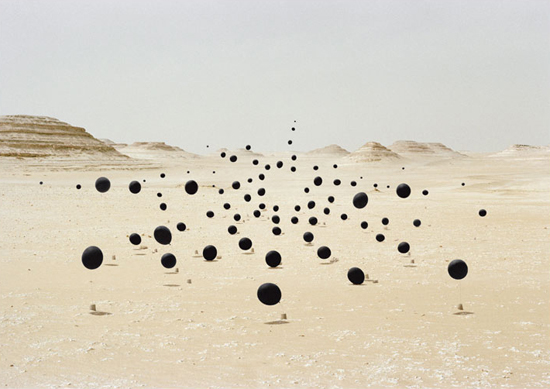Interrupting Infinity Exclusive Commentary. © 2011 by David St.-Lascaux

“Death of an image #12,” Andrea Galvani.
Image courtesy the artist and the Muelensteen Gallery; © 2006.
The Aperture Foundation
28 July 2011
by David St.-Lascaux
I KNOW A FEW THINGS ABOUT LIGHT. For example, in hexadecimal parlance, I know that #000000 (or, quicker, #000) produces black, the RGB absence or complete absorption of light, and #FFFFFF is full strength – white – reflected light. In analog paper photography, I know that white is produced by a masking effect on a black & white film negative; in color it’s essentially the same, with different chemicals.
Nothing that I know about light explains the illusive first impression that Andrea Galvani’s photos produce on the visual cortex. (The marketing/curatorial characterization of Galvani as “cerebral” is accurate and graphically lucid.) As a bonus, when one learns of Galvani’s attitude toward the medium, and of his creative impetus, additional dimensions coalesce.
“Four Works” was a one-day show at Aperture curated by Nora Lawrence as part of the 2011 Chelsea Art Walk. As might be expected from the title, this show was minimalist in quantity – my only complaint. The inappropriate massing at the Noguchi museum may beg a ninety percent reduction in displayed work, but there was no apparent reason for Galvani to withhold supply in Aperture’s ample space, especially given that these works are intended to be, if imprecisely, serial, annual calendar pages documenting Galvani’s creative timespan: 2005, 2005, 2006 and 2009. On the other hand, their spatial organization, while not obvious, was explained by Galvani as booklike: the techno-mysterious “Higgs Ocean #5 (2009; I don’t know much about this, but Wikipedia says that the “Higgs boson is a hypothetical massive elementary particle” that everyone is looking for; here are some explanations from the University of Cape Town’s Department of Physics) being the dark, light-absorbing cover; the op art pair of desert dottings, “Death of an image #12″ and “Death… #2″ analogous to ink-on-paper interior pages, and the alien-possessed solitary tree, “Death… #4,” a literally reflective back cover. Whether or not one buys Galvani’s bibliographic analogy, each of these works has a unique, surreal quality that invites inspection and reflection, and produces the desired effect: it’s art in the sense that Picasso said that art is “not nature,” and in the sense that it’s hindbrain stuff – emotional and, as Galvani articulately proposes, “primordial.”
The last point is of note given Galvani’s attitude toward his medium, which is that photography is incidental to his objective to “challenge and expand the boundaries of language, space and time that illuminate the invisible mechanisms that construct and transform life.” I suppose that Galvani could create these works as sketches or paintings, but the fact that they are photographs and that Galvani quite satisfactorily, even brilliantly, utilizes light and anti-light in their creation – and to produce otherworldly effects, suggests that he is underselling himself.
The works themselves, quickly: “Higgs Ocean #5″ is of autos in the desert at night with their wheel wells lit from within, requiring at least a double take and a zooming-in inspection to resolve. “Death…” #s 12 and 2 are seeming clusters of matte black balloons in remote, arid environments – one shot in the Libyan desert and another against a cliff in Corsica – that are at once Rorschachian inkspots, atomic particles and negative constellations, for starters. In “Death… #12,” even the inverted sandpail anchors appear to float in space, while the entirely unmediated buttes in the background add a surreal contrast to the black hole foreground entirely in the manner of René Magritte and Yves Tanguy. While “Death… #4″ has numerous clichéd solitary-tree-in-open-field precursors, its triune headlight ornaments (actually mirrors reflecting the sun) create a burning bush effect that would frighten a Neanderthal, or Canaanite, and possibly a Modern.
It’s easy to like an artist who works at the North Pole and who uses an actual desert as a creative sandbox. That Galvani regards his work aspirationally as scientific research, as experimental, “harness[ing] natural phenomena like snow, fog and ice,” so begs for broader exhibition. One looks forward to Galvani’s upcoming show at Muelensteen Gallery (formerly Max Protetch) in February 2012.
* * *

